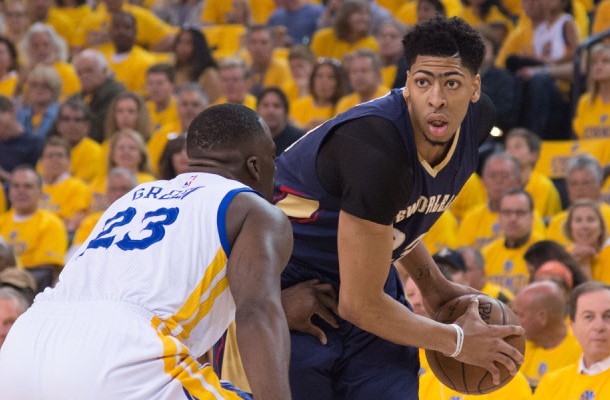When incredible talent and radical injury misfortune intersect as precisely as they have in the career of Anthony Davis, the organization overseeing it all is bound to get swept up in a bit of what you might call “back-and-forth”. The Pelicans’ success during Davis’s career (longer than you might think at this point) has been impacted directly by the young big man’s luck. The wild highs and lows that the franchise has experienced seem unprecedented in the present, but looking at recent history helps contextualize the relative successes of the Pelicans organization.
Quick, let’s get one thing out of the way: Drafting Anthony Davis was not a mistake, and proving that to be true or untrue is not the purpose of what you’re about to read. The Hornets hopped right over the Bobcats in the lottery in 2012, and they were blessed with a once-in-a-lifetime opportunity to draft a surefire superstar. Regardless of injury luck, you take that chance every time. It’s one of the best lessons we can learn from Sam Hinkie and the Philadelphia 76ers’ Process.
Philly selected Nerlens Noel, Joel Embiid and Ben Simmons all in the span of a few seasons simply because they had the best chance to break through as superstars. Additionally, there were no real injury concerns with Davis heading into the 2012 draft. He suffered a knee injury in the NCAA Tournament, but returned to action later in the same game in which he got injured. Surefire, in this case, really means surefire.
Speaking, though, of lessons to be learned from other franchises, the relationship that manifested between the Golden State Warriors and Steph Curry’s ankles early in his career was one that changed the history of basketball. Not to put pressure on the Pelicans, but managing injuries early in a superstar’s career can be the difference between forming a legacy and losing a generation of fans. That’s the gravity of this situation.
Curry’s career unfortunately does not look all that similar to that of Davis. Outside of the lockout-shortened 2011-12 season, in which Curry missed 40 games with surgery on his right ankle, he’s only missed 24 games in his other eight seasons.
Davis had missed 48 games in the four seasons preceding this one. The best thing to remember here is the most recent event along the timeline of the power forward’s injury history. Late last season, after the games stopped mattering and Toney Douglas had started mattering, Davis revealed an injury that had impacted his game for the past three seasons. Of course, playing through this injury probably affected his body negatively in other ways. We know that overcompensating can be terrible for the rest of a body in recovery, and so we also can begin to understand Davis’s struggles to stay healthy by looking at it through this lens.
Missing in Action: Anthony Davis has had trouble staying on the court (by @BenGolliver) https://t.co/fO75R2uG3U pic.twitter.com/asN6loxuoo
— The Crossover (@TheCrossover) March 21, 2016
A better comparison than Curry, in many ways, is Kyrie Irving. Irving has missed a startling 94 games through six NBA seasons, but played 75 games in 2014-15 and then 72 this year. His only unhealthy season lately was caused by a wild knee fracture in the 2015 NBA Finals.
The breadth of Irving’s injury misfortune strikes a familiar twinge for Pelicans fans: a concussion first, two breaks in his hand, a hyperextended knee, then the kneecap fracture. It’s enough to remind you of this infamous tweet from NBA.com’s John Schuhmann:
Anthony Davis’ injury history is kind of bizarre. Nothing major, but a LOT of minor stuff in less than 3 seasons. pic.twitter.com/N1QvG9bNhD
— John Schuhmann (@johnschuhmann) March 23, 2015
Regardless, we’re looking back now on Davis’s most healthy season. More interesting is the fact that it was also the season in which he played the most at the center position. For most of the year, before the arrival of DeMarcus Cousins, Davis was the focal point of the Pelicans’ small-ball attack on both sides of the ball. He managed to stay healthy while protecting the rim remarkably well and handling the highest offensive usage rate of his career. Cue the relieved sigh.
None of this is any use for a single uncompetitive season if the team can’t count on it going forward. There are two lines of thought at this point: either the random dumb luck of Davis’s particular collection of injuries swung positively this season and it will regress back next year, or offseason knee surgery, labrum rehabilitation and hard work to manage his body have made a positive difference. This year, it was probably some combination of both that led to his ability to stay on the court for so many games.
Davis also left several games early, and that can be just as bad as the missed games that show up in the stats charts. However, in a situation like this, small steps like being available for games are beneficial and almost symbolic of progress. It’s impossible to look back on last season with anything but optimism in regard to the health of the franchise centerpiece.

One response to “Anthony Davis made healthy progress during the 2016-17 season”
[…] When incredible talent and radical injury misfortune intersect as precisely as they have in the career of Anthony Davis, the organization overseeing it all is bound to get swept up in a bit of what you might call “back-and-forth”.Read more » […]